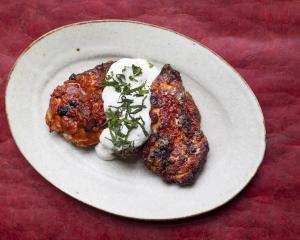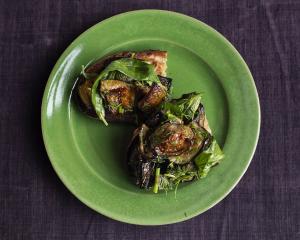Throughout Otago, people with a love of food and fresh produce are turning out amazing products. For some it is just a hobby, for others it has turned into their livelihood. Mark Price finds out their story.
Nothing, you might say, too unusual about that.
But the Holsts' rabbit dishes contain an unusual ingredient.
Not for them the light, lean, tough rabbits of the Central Otago hills - they prefer to grow their own.
In their back garden, Mr and Mrs Holst keep four big, fat, fluffy white female rabbits and one male - George.
Each year, each female has five litters of 10 baby rabbits (or kits) for a grand total of 200 rabbits.
Mr Holst says the females are capable of producing more, but he prefers they are not ''too fatigued'' and he allows them to rest between breeding cycles.
When his live rabbits weigh 2.5kg each and are ''dressed'' for the pot they provide about 1.5kg of meat.
''They are very high in protein; low in cholesterol. Nutrition-wise, it is the best meat that you can eat.''
Asked how the meat differs from that of wild rabbit, Mr Holst jokes ''there are no lead pellets''.
''And the ones in the wild, you don't know what they have been eating. Maybe the grass has been sprayed, for example.''
The rabbits - a cross between Californian and New Zealand whites - are fed lucerne and ''a medley'' of vegetables and clover.
They are kept off the ground, in cages laid with straw.
Mr Holst cleans the cages once a week, which takes about an hour. He considers them easy to look after.
''Hygiene is very important and also because we have neighbours we don't want to have a smell.''
His breeding stock must be inoculated against the calicivirus but the young ones are eaten before they are 10 weeks old so do not need to be inoculated.
Mr Holst also exchanges stock with other rabbit breeders to retain genetic diversity.
He pats the rabbits to reduce their stress and once a litter has grown to a suitable size, he spends a weekend preparing the rabbits for the freezer - killing them himself with a technique designed also to minimise stress.
Mr Holst says the primary reason he and his wife raise rabbits is to ''take charge'' of what they eat. He is not allowed to sell the rabbit meat.
''It's just for personal consumption.
''And I feed the innards to the chickens ... and the chickens love it.''
Mrs Holst is particularly fond of a rabbit recipe from Cuisine, The Seasonal Cook.
Ingredients
¼ tsp saffron threads
500ml chicken stock
4 tbsp olive oil
1.5kg whole rabbit, cut into 8-10 pieces
1 onion, chopped
3 sprigs thyme
100g black olives
½ tsp salt (only use if stock is not salty)
½ tsp freshly ground black pepper
150ml dry white wine
600g waxy potatoes well scrubbed, cut into bite-sized cubes
Method
Grind the saffron a little in a mortar and pestle then combine with ½ cup of the stock and set aside.
Heat 2 tbsp of the olive oil in a large heavy-based casserole or saucepan over medium-high heat. Add the rabbit and brown all over then remove and set aside.
Add the onion and the remaining oil and reduce the heat to medium. When the onion is browned, place the rabbit in the pan along with the thyme, olives, salt (if using) and pepper.
Add the wine and reduce until it has almost disappeared (about 8min) then add the remaining stock. Reduce the heat to very low and cook, covered, for 40min, turning the rabbit occasionally.
Meanwhile, place the potato cubes in a saucepan with a little salt, cover with water and bring to the boil. At boiling point, remove from the heat, drain and set aside. After the rabbit has been cooked for 40min, add the potatoes and the reserved saffron stock, cover and cook for a further 20min.
Discard the thyme sprigs then use a slotted spoon to remove the rabbit, potatoes and olives to a warm serving dish and cover with foil. Bring the remaining juices in the saucepan to the boil and reduce for about 5min then pour over the rabbit. Serve with a rocket salad or green vegetables.
Serves 4.












